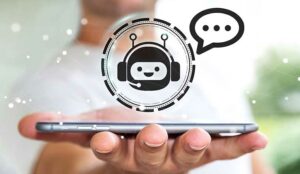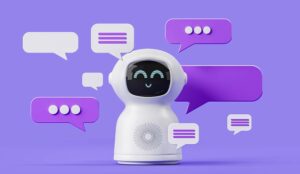Annette Miesbach at NICE CXone explores chatbots, giving examples of the best ones and explaining what makes them great.
Have you heard about chatbots? Silly question, right? Of course you have, there’s been plenty of buzz during the last several years about how chatbots will revolutionize the customer service industry.
This buzz has ranged from “chatbots will replace all human agents” to “chatbots are overrated” and everything in between.
As chatbot technology has matured and we’ve been able to witness it in action, it’s become clear that for the foreseeable future we’ll still need human agents to resolve more complex customer issues.
But although earlier versions of chatbots may have left people feeling underwhelmed, today’s bots have advanced capabilities that enable them to play important roles in sales, marketing, customer service, and operations.
If you’re new to chatbots, it can be difficult to envision where a bot makes sense in your organization’s customer journey. Looking at how other companies have deployed and are successfully using bots will be both helpful and can inspire you to move forward with your own solution.
This article will provide real-life examples of effective chatbots plus tips for identifying and implementing the best chatbot for your contact centre.
Contact Centres are Investing in AI and Chatbots
As consumer adoption of online chat in contact centres increases, the case for chatbots becomes even more compelling.
NICE CXone’s 2020 CX Benchmark study revealed that about one third of consumers had used chat for a customer service interaction during the previous three months, showing continued growth compared to the previous year.
Additionally, consumers rate online chat as one of the top three most satisfying channels.
For their part, in 2020 72% of businesses supported online chat, a 6 point increase over the prior year. Chat has become an established channel, right up there with phone and email. And the next iteration of chat for many companies includes the addition of self-service capabilities enabled by chatbots.
Almost half (46%) of the businesses in our study already use chatbots for self-service. This is an evolution similar to what we’ve observed with voice interactions in the past: today, many are front-ended with IVR self-service.
Businesses perceive chatbots favorably not only for the operational benefits, but because of what they can do for CX and the resolution of customer issues. Their research revealed that 72% of businesses believe chatbots make things easier for customers.
Further, they found that AI usage in general is growing among businesses, with 66% of them using at least one AI-powered tool in their contact centres. The outlook is bright for AI and chatbots, there’s no indication of adoption slowing down.
But there are some weaknesses that need to be addressed before there’s widespread consumer adoption of chatbots. Although the technology has advanced significantly, chatbots are still most effective at handling simple, narrowly defined tasks.
Most businesses and consumers think they need to become smarter and 83% of consumers who enter into a chatbot interaction expect to switch to an agent-assisted channel at some point of the interaction. Not exactly a vote of confidence!
Despite consumer reluctance, or maybe because of it, they found that 32% of businesses plan to invest in chatbots in the coming year. Significant investments can lead to technology improvements that increase customer adoption of chatbots and related solutions such as virtual assistants.
About Bots and Other Online “Life Forms”
The world of bots comes with its own jargon. You’ll hear terms like bots, chatbots, voice bots, virtual assistants, and virtual agents, bandied about and it can make things quite confusing.
Some are just different names for the same thing, but in the case of chatbots versus virtual agents, there are some significant differences. Let’s take a closer look at the two.
What is a Chatbot and How it is Different From a Virtual Assistant?
Chatbots are programs that can be deployed online, in social channels, or the back office to help automate simple, repetitive tasks.
Organizations build and deploy chatbots based on business needs, so each chatbot you encounter may serve a unique purpose and have capabilities different from other chatbots.
Because chatbots are most successful when they are used for handling narrow, well-defined tasks, customer service bots are well-suited for activities such as:
- Answering FAQs
- Completing secure and accurate transactions
- Providing information, documents and other contextual support
- Assisting agents by suggesting next steps and retrieving knowledge base content
Chatbots are rules-based and usually task oriented and may or may not use artificial intelligence. The tasks chatbots can perform are typically limited to sharing and gathering information. Being rules-based means a chatbot relies on a decision tree to complete its tasks.
For example, the bot may begin a customer interaction by providing the customer with three options to choose from. The chosen option will dictate what the chatbot says or does next. Rules-based chatbots require human intervention in order to change or expand their knowledge and capabilities.
While opinions on what is a chatbot and what is a virtual agent can vary based on the opinion of an individual or the position of a vendor, the general rule is this: virtual assistants tend to be more sophisticated than chatbots because they leverage artificial intelligence capabilities such as natural language processing, natural language understanding, and machine learning.
The language capabilities help virtual assistants understand human speech, making them capable of determining intent and enabling them to respond appropriately.
Machine learning allows virtual assistants to become smarter with use, meaning they can expand certain abilities on their own and “learn” by appropriating knowledge from interactions they have participated in. Virtual assistants are typically better than chatbots at resolving more complex customer issues.
What Makes a Chatbot Great – Chatbot Best Practices
Since so many organizations have been experimenting with chatbots during the last several years, there are plenty of lessons learned to help guide businesses with their new chatbot implementations.
The following best practices are based on experiences from organizations that have already successfully implemented chatbots.
Start Small, Then Grow and Expand
Because chatbots will impact the customer experience, organizations should proceed cautiously with new bots by piloting, assessing, refining, and then expanding.
Fortunately, chatbots are well-suited to this implementation approach because businesses can start them off handling just a couple of tasks and / or only deploy them in limited digital channels.
For example, the chatbot could be piloted with it handling only order status requests and password reset transactions. Or it might be piloted on the corporate website with future plans to add it to Facebook Messenger.
Analyze NLU, Sentiment and the Customer Journey Before Building Bot Use Cases
Before you build use cases, do some due diligence on NLU, customer sentiment and the customer journey. You need to have a firm grasp of the strengths and limitations of a chatbot’s ability to understand human language.
Assessing customer sentiment, preferably with specific touchpoints, is also in order because you don’t want to aggravate an already frustrating touchpoint with a pilot of a chatbot that will likely have some issues. And you want to put a chatbot at a place in the customer journey where it makes sense.
For example, a support chatbot should be available when a customer’s behavior signals they might need help.
Communicate Often With all Stakeholders Throughout the Process
There will be internal interest any time you implement new, customer-facing technology.
Afterall, everyone in the organization has a vested interest in making sure customers are taken care of. However, more “exotic” technologies like chatbots will likely increase internal focus on your project. Communicate often and transparently with stakeholders.
In particular, set expectations about what your pilot chatbot will and won’t be able to do. And don’t forget these stakeholders include your agents, who will likely have a lot of questions about how the chatbot will impact processes and their roles.
They found that while some agents may feel threatened by the introduction of a bot that they sometimes regard as “competition”, involving them in the introduction will go a long way towards alleviating that fear.
For example giving agents a say in which interactions are good “candidates” to be taken over by a bot serves multiple purposes: agents usually do not like working on repetitive, simple parts of interactions such as collecting information or resetting a password – but that is exactly where bots can shine.
Agents get to focus on interactions where human problem solving skills are needed. A win-win situation for everyone involved!
Don’t Try to Automate at all Cost – Choose the Right Transactions
Recall that chatbots are more successful when used for narrow, predictable, well-defined tasks. When this criteria intersects with higher volume contact types, you probably found your chatbot’s sweet spot. To ensure a successful chatbot, pick the right tasks for it to perform.
The best chatbots for contact centres don’t bite off more than they can chew.
Provide Customers with Guidance and Context
Your chatbot is a sophisticated form of customer self-service. As such, you want your customers to have a high success rate with the bot so they don’t have to transfer to an agent. Providing context and guidance are effective ways to do this.
For example, build your bot to anticipate likely next steps so it can ask customers guiding questions like, “Now that you know your balance, would you like me to help you pay your bill?”
Create a Smooth Path to an Agent
Did you know that half of customers that attempt self-service transfer to an agent to complete their transactions? Plan for this by building a smooth path to agent assistance.
This should include making it obvious to customers how to get agent help and providing agents with information from the chatbot interaction so customers don’t need to repeat their identities and issues.
Also, many of our customers that use chatbots find that giving consumers the option to reach a live person easily when needed greatly improves acceptance and willingness to use the channel.
Reuse Content and Web Processes You’ve Already Created and Developed
To avoid reinventing the wheel as part of your chatbot initiative, reuse existing content and processes. This will help you reduce timelines, expedite implementations and avoid adding unnecessary complexity through duplication.
As an example, if you want to have a bot reset a password, then by and large the procedure that you have defined for when an agent does this can serve as guidance for what the bot will need to do, or if a consumer enquires about the status of a shipment, then the bot will need to collect the same information your agents needed to identify the customer, accessing to the same systems your agents use to source the information.
Measure, Report, Analyze – you Can’t Manage What you Can’t Measure
You need to consistently assess your chatbot’s performance throughout its life cycle. This will enable you to make data-driven decisions about bug fixes, enhancements, and expanding capabilities.
Know what you want to measure when you design the chatbot so the development will include relevant measurement capabilities if needed.
Reduce Management Effort with a Tightly Integrated Solution
Ultimately, your chatbot should reduce contact centre costs and accelerate engagements by automating specific transactions and completely resolving customer issues.
This means, for example, if the bot helps a customer schedule an appointment, the bot should be able to retrieve available appointment times and write the new appointment into the customer scheduling system.
Successful automation with bots requires tight integration with back-office systems so that ideally, no manual intervention is needed.
Choose a Solution that is More Flexible and Scalable than What is Currently Needed
Once your chatbot is a finely tuned customer support machine, you don’t want to have to rip and replace when adoption grows or you are automating more workflows. Make flexibility and scalability part of your chatbot selection criteria.
Real-world Examples of Chatbots and What Makes Them Great
Not all chatbots are created equal. Some chatbots are more effective than others at providing useful functionality and great CX. Here are five noteworthy chatbot examples built on best practices and worthy of emulation.
Erica (Bank of America)
Erica, Bank of America’s virtual assistant, leverages AI capabilities like natural language processing to help the bank’s customers manage their financial lives by facilitating tasks like checking account balances, scheduling payments, sending money to friends, and requesting payment deferrals.
Erica is a great example of how chatbots and virtual assistants can help both consumers and businesses. Erica scales as needed: in the early days of the COVID lockdowns, a million new Erica users were added each month.
And, she is available all day, every day and you don’t even need to wear a mask or wait in line to enter the premises!
What makes Erica great:
- Provides useful and personalized functionality to resolve customer issues
- Able to scale quickly and seamlessly
- Bank of America started small and progressively added functionality
- Seamless transfer to an agent – customers don’t have to re-authenticate their identity or repeat their issue
Juliet (Westjet)
Canadian airline Westjet introduced Juliet in 2018 to answer frequently asked questions and assist customers with transactions such as booking or changing flights, checking flight status, and processing travel refunds.
Juliet resides in Facebook Messenger, Google Assistant, and WhatsApp, where it has resolved over 530k tickets. During peak periods of the pandemic, Juliet was able to resolve 200 inquiries per minute.
Juliet has an 87% resolution rate, up significantly from a 24% resolution rate at launch, and Westjet has experienced a 24% increase in customer satisfaction since implementation. Maybe, one day, Juliet will find her Romeo yet – wait… does Air Transat have a bot? Just joking, of course…
What makes Juliet great:
- Handles useful, targeted transactions
- High resolution rates
- Can scale
- Westjet consistently focused on improving Juliet’s effectiveness (as evidenced by the substantial increase in resolution rates)
- Positive impact to customer satisfaction
- Clear path to an agent
Dom (Domino’s Pizza)
You can find Domino’s voice-controlled assistant in their company app and Facebook Messenger. Dom assists customers with placing orders and tracking delivery status. If you’re a current customer, you can even quickly place an order by simply telling Dom “pizza” or by sending it a pizza emoji.
Dom is known for its humorous personality and even sent users an apology after a rough start.
What makes Dom great:
- Useful functionality
- Engages customers with a fun personality
- Domino’s stuck with the bot and improved it after a rough rollout
- Available in multiple digital channels
XiaoIce
Microsoft introduced XiaoIce, a Chinese-speaking social assistant, in 2014 and it quickly became a digital sensation, holding half a billion conversations within the first three months. XiaoIce now has over 650 million followers.
The bot was created using highly sophisticated AI technology and was trained using 7 million publicly available conversations. The result is a social assistant that understands context and nuance and uses sentiment analysis so it can show empathy.
XiaoIce answers questions (Microsoft dubbed it “Cortana’s Little Sister”), recites poetry, tells jokes, and even sings. Interestingly, the bot was censored in 2017 when she began making negative comments about the Chinese government, a consequence of machine learning.
It has since been programmed to avoid conversations about the government. XiaoIce was so successful that Microsoft spun it off into its own entity in 2020.
What makes XiaoIce great:
- Can hold more human-like conversations than most bots
- Engaging personality and capabilities make it popular and widely used
- Use of sentiment analysis enables it to respond appropriately to human emotion
- It understands context and entity relationships which allows it to have better conversations for longer amounts of time
Benji (AskBenji)
If you have been through the Federal Student Aid (FAFSA) process recently, you’ll know that it can be confusing. Knowing this, Arizona State University created a bot that’s available via SMS to guide students through this critical process.
Benji is a rules-based bot that uses natural language processing to identify keywords and respond appropriately. It can answer questions about FAFSA deadlines, links students to the FAFSA website, and more. Benji reduces student stress by providing quick answers to common questions.
What makes Benji great:
- Available in a channel very relevant to the target, digital native audience
- Clearly defined, narrow responsibilities – Benji only answers questions about the FAFSA process
- Addresses a genuine need
Final Thoughts
As you can see, these five successful chatbots were designed and implemented using many of the best practices we discussed.
Of particular note is that several of the chatbots started small (and sometimes not very successfully) and their organizations focused on improving them and adding more responsibilities over time. Another characteristic of these effective chatbots is that they provide useful functionality to customers.
But not all chatbots serve a practical purpose. Some, like mattress firm Casper’s insomnobot3000, are purely for entertainment that raises brand awareness. You can text insomnobot3000 between 11pm and 5am to engage in some witty banter. It’s much better for you than midnight snacking!
This blog post has been re-published by kind permission of NICE CXone – View the Original Article
For more information about NICE CXone - visit the NICE CXone Website
Call Centre Helper is not responsible for the content of these guest blog posts. The opinions expressed in this article are those of the author, and do not necessarily reflect those of Call Centre Helper.
Author: NICE CXone
Published On: 10th Jun 2021 - Last modified: 29th May 2024
Read more about - Guest Blogs, Annette Miesbach, NICE CXone






 NICE CXone combines best-in-class Omnichannel Routing, Workforce Engagement, Analytics, Automation and Artificial Intelligence on an Open Cloud Foundation.
NICE CXone combines best-in-class Omnichannel Routing, Workforce Engagement, Analytics, Automation and Artificial Intelligence on an Open Cloud Foundation. 





























